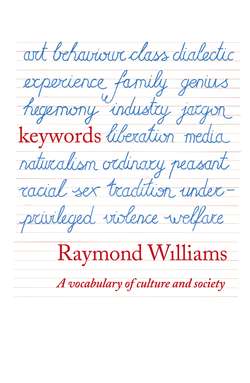Читать книгу Keywords: A Vocabulary of Culture and Society - Raymond Williams - Страница 16
BEHAVIOUR
ОглавлениеBehave is a very curious word which still presents difficulties. There was an oE behabban – to contain, from rw be – about, habban – to hold. But the modern word seems to have been introduced in C15 as a form of qualification of the verb have (cf. sich behaben, in G), and especially in the reflexive sense of ‘to have (bear) oneself’. In C16 examples the past tense can be behad. The main sense that came through was one of public conduct or bearing: the nearest modern specialization would perhaps be deportment, or the specialized sense (from C16) of manners (cf. C14 mannerly). In the verb this is still a predominant sense, and to behave (‘yourself’) is still colloquially to behave well, although to behave badly is also immediately understood. In the course of its development from its originally rather limited and dignified sense of public conduct (which Johnson still noted with an emphasis on external), to a term summarizing, in a general moral sense, a whole range of activities, behave has acquired a certain ambivalence, and this has become especially important in the associated development of behaviour. Use of the noun to refer to public conduct or, in a moral sense, to a general range of activities is still common enough; the classic instance is ‘when we are sick in fortune, often the surfeits of our own behaviour’ (King Lear, I, ii). But the critical development is the neutral application of the term, without any moral implications, to describe ways in which someone or something acts (reacts) in some specific situation. This began in scientific description in Cl7 but is not common before C19. The crucial transfer seems to take place in descriptions of material objects, with a strong sense of observation which is probably related to the earlier main sense of observable public conduct. Thus: ‘to watch … the behaviour of the water which drains off a flat coast of mud’ (Huxley, 1878). But the term was also used in relation to plants, lower organisms and animals, and by lC19 was in general use in its still current sense of ‘the externally apparent activity of a whole organism’. (Cf. animal behaviour, and its specialized synonym ethology; ethology had previously been defined as mimicry, Cl7; the science of ethics, C18; the science of character (Mill, 1843). The range from moral to neutral definitions is as evident as in behaviour, and can of course be seen also in character.)
One particular meaning followed from the extension of the methodology of the physical and biological sciences to an influential school of psychology which described itself (Watson, 1913) as behaviourist and (slightly later) behaviourism. Psychology was seen as ‘a purely objective experimental branch of natural science’ (Watson), and data of a ‘mental’ or ‘experiential’ kind were ruled out as unscientific. The key point in this definition was the sense of observable, which was initially confined to ‘objectively physically measurable’ but which later developments, that were still called behaviourist or neo-behaviourist (this use of neo, Gk – new, to indicate a new or revised version of a doctrine is recorded from C17 but is most common from lC19), modified to ‘experimentally measurable’, various kinds of ‘mental’ or ‘experiential’ (cf. SUBJECTIVE) data being admitted under conditions of controlled observation. More important, probably, than the methodological argument within psychology was the extension, from this school and from several associated social and intellectual tendencies, of a sense of behaviour, in its new wide reference to all (? observable) activity, and especially human activity, as ‘interaction’ between ‘an organism’ and ‘its environment’, usually itself specialized to ‘stimulus’ and ‘response’. This had the effect, in a number of areas, of limiting not only the study but the nature of human activity to interactions DETERMINED (q.v.) by an environment, other conceptions of ‘intention’ or ‘purpose’ being rejected or treated as at best secondary, the predominant emphasis being always on (observable) effect: behaviour. In the human sciences, and in many socially applied (and far from neutral) fields such as COMMUNICATIONS (q.v.) and advertising (which developed from its general sense of ‘notification’, from Cl5, to a system of organized influence on CONSUMER (q.v.) behaviour, especially from lC19), the relatively neutral physical senses of stimulus and response have been developed into a reductive system of ‘controlled’ behaviour as a summary of all significant human activity. (Controlled is interesting because of the overlap between conditions of observable experiment – developed from the sense of a system of checks in commercial accounting, from C15 – and conditions of the exercise of restraint or power over others, also from C15. The two modern senses are held as separate, but there has been some practical transfer between them.) The most important effect is the description of certain ‘intentional’ and ‘purposive’ human practices and systems as if they were ‘natural’ or ‘objective’ stimuli, to which responses can be graded as ‘normal’ or ‘abnormal’ or ‘deviant’. The sense of ‘autonomous’ or ‘independent’ response (either generally, or in the sense of being outside the terms of a given system) can thus be weakened, with important effects in politics and sociology (cf. ‘deviant groups’, ‘deviant political behaviour’), in psychology (cf. RATIONALIZATION) and in the understanding of intelligence or of language (language behaviour), where there is now considerable argument between an extended sense of behaviourist explanations and explanations based on such terms as generative or CREATIVE (q.v.).
Apart from these particular and central controversies, it remains significant that a term for public conduct should have developed into our most widely used and most apparently neutral term for all kinds of activity.
